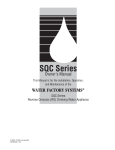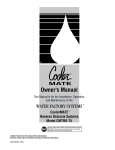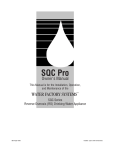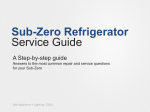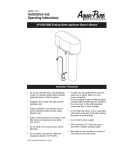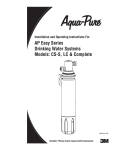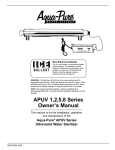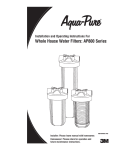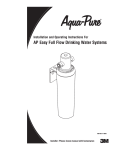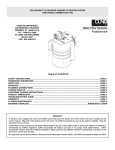Download Water Factory Systems FaucetMATE Owner`s manual
Transcript
™ ™ Owner's Manual This Manual is for the Installation, Operation, and Maintenance of the ™ WATER FACTORY SYSTEMS ™ Faucet MATE FM DWS 1500 Drinking Water Appliance 98-91122 1009 Installer: Leave with Homeowner. Introduction This manual explains the installation and maintenance instructions for the CUNO/Water Factory Systems™ FaucetMATE™ FM DWS 1500. Please read each section of this manual carefully. The specific model chosen should be appropriate for the local water conditions and the customer’s needs. Check the Performance Data Sheet which specifies performance characteristics and the conditions of use. This CUNO/Water Factory Systems drinking water appliance is designed to connect permanently to a home plumbing system. To ensure the installation conforms to your state and local plumbing codes, it is recommended that the installation be performed by a qualified specialist for drinking water appliances or a licensed plumber. Failure to install as instructed will VOID the warranty. Table Of Contents Installation Instructions Installation Precautions ..............................................................................................................................3 Determine System Location .......................................................................................................................3 Prepare The Area For Installation ...............................................................................................................3 Prepare The Appliance For Installation .......................................................................................................4 Locating The Faucet ...................................................................................................................................4 Make The Faucet Mounting Hole ................................................................................................................4 Mounting The Faucet ..................................................................................................................................5 Mounting The Drinking Water Filtration Appliance .....................................................................................5 Installing The Feed Water Valve/Adapter ....................................................................................................5 Make Tubing Connections ..........................................................................................................................5 Procedure For Installing FM DWS 1500 Water Appliance ..........................................................................6 Replacement Cartridge Change Instructions ..............................................................................................7 Illustrations System Location (Figure 1) ........................................................................................................................8 Faucet Installation (Figure 2) ......................................................................................................................9 How To Use ‘Push-In’ Connections (Figure 3) ...........................................................................................9 2 Installation Precautions • The filter must be installed with the inlet and outlet ports as labeled. Make sure not to reverse connections. Procedure for Installing FM DWS 1500 A. Determine System Location • Do not install on hot water line. Maximum temperature allowed is 100°F (38°C). • Do not install on line pressure above 125 psi (862 kPa). • Do not use torch or other high temperature sources near filter head or plastic cartridge. • Do not install near electric wires or water pipes which will be in path of drill when selecting the position to mount the bracket. • Do not install in direct sunlight. • Protect from freezing. Drain filter when room temperature drops below 40°F (4.4°C). • Allow minimum of 2" (5 cm) clear space under filter to facilitate cartridge change. • Mount filter in such a position as to prevent it from being struck by other items, such as wastebaskets, etc. • Do not use with water that is microbiologically unsafe or of unknown quality without adequate disinfection before or after the system. Systems certified for cyst reduction may be used on disinfected waters that may contain filterable cysts. The filtration system can be located under a sink. Never install in an area of the home where the temperature may drop to freezing as damage to the system will result. The exact placement of the various components of the appliance will vary from installation to installation. The installer, in conjunction with the customer, must decide on where to place the faucet and filtration system by balancing the homeowners convenience with ease of installation and servicing. (See Fig. 1) B. Prepare The Area For Installation Remove supplies from under the sink and stack them neatly away from the working area. Arrange a light for the work area, if necessary. If a basement installation is called for, determine where components will be located and how they will be mounted. Special mounting brackets and hardware may be necessary to secure the system to a wall or ceiling joints. Inspect cold water supply line to determine if any special fittings, in addition to what is included in the kit, are required. NOTE: It is a good idea at this time to check the condition of the customer’s undercounter plumbing for any existing or potential leaks. The customer should be advised of any problem so there is no misunderstanding of who is responsible. • System installation must comply with existing state or local plumbing codes. • IMPORTANT: Some local plumbing codes may prohibit the use of saddle-type valves and/or drain connections. The use of saddle-type valves are prohibited in Alaska, Delaware, Idaho, Kentucky, Massachusetts, Michigan, Minnesota, New Hampshire, Ohio, and South Dakota. Check your local plumbing codes for any restrictions that apply. Massachusetts CMR 248 strictly prohibits the use ofsaddle-type valves. The feed water connection must conform to applicable plumbing codes. 3 C. Prepare The Appliance For Installation D) Clean up sharp edges with a file if necessary. Open shipping carton and remove components. Check that all installation parts are present which includes the filter assembly, faucet, installation hardware and tubing. D. Locating The Faucet Select a sink or countertop location at least two inches in diameter on which to mount the drinking water faucet. The faucet should be positioned so that it empties into the sink. Make sure the location directly underneath this area is free of obstruction in order to accommodate the faucet assembly. If the sink already has a hole provided that can accommodate the faucet, then no drilling is required and you can proceed to the section on mounting the faucet. (See Fig. 2) E. Make The Faucet Mounting Hole IMPORTANT: It is mandatory that safety glasses be worn during sink hole drilling operations to prevent eye injury. IMPORTANT: Extreme care must be taken when drilling the hole for the faucet. The surface material is hard and brittle and easily chipped or cracked. The manufacturer assumes no responsibility for sink damage resulting from this installation. A wide variety of faucet mounting situations may be encountered, the most common being stainless steel and ceramic-on-metal sinks. Consult a plumber for the other materials that may be encountered. Before starting the hole making operation, always check below the sink so that nothing interferes with mounting the faucet such as reinforcing ribs, support brackets or cabinet construction. Stainless Steel Sink Recommended tools: • Center punch • Variable speed drill and high speed drill bits • Chassis punch 9/16” size • Protective Gloves Procedure: A) Center punch a small indent at the desired faucet location. Porcelain/Enamel/Ceramic on sheet metal or cast iron base: Recommended Tools: • Variable speed drill • Porcelain cutter tool set 9/16” size • Plumber’s putty It is important to understand what is involved in this procedure. First, the glassy layer of porcelain must be penetrated through to the base metal. Second, a center disc of porcelain must be removed while protecting the surrounding porcelain against chipping or fracturing. Third, the base metal must be drilled through to complete the hole. IMPORTANT: When using a porcelain cutter it is critical to take precautions that it is always in a sharpened condition. Dull cutters are known to chip sinks. Procedure: A) Mark the center for the 9/16” hole. B) Form shallow putty dam around hole area and fill with enough water to lubricate carbide drill bit. C) Carefully drill pilot hole through porcelain/enamel and base metal using carbide type pilot drill. IMPORTANT: Always operate drill with light pressure at slow speed (300-400 rpm). D) Insert pilot tip of spring loaded porcelain cutter into pilot hole. E) Drill porcelain/enamel using spring-loaded porcelain cutter, making certain a complete ring has been cut through the porcelain/enamel to the metal base. F) Change to the metal cutter. With slow speed and light pressure, cut away the inner porcelain/ enamel disc down to base metal. Make certain that the cutter does not touch outer rim of the cut porcelain/enamel. Continue with this bit to cut through metal until sink has been completely penetrated. B) Slowly drill required pilot hole for the chassis punch. C) Set up the chassis punch per instructions and tighten nut to cut the desired hole size. 4 F. Mounting The Faucet H. Installing The Feed Water Valve/Adapter 1. Remove all hardware from the threaded nipple of the faucet except for the plastic base plate. Use a small amount of putty to seal the base plate. Due to variations in plumbing types and due to various State and Local plumbing codes, this product does not include a feed water adapter/valve. Please obtain the appropriate code compliant adapter/valve from the retailer where this product was purchased. 2. Put the blue tubing and threaded nipple through the faucet mounting hole and position the faucet spout over the sink. 3. From below sink/countertop, assemble the plastic bottom washer, star washer and hex nut onto the threaded nipple and tighten by hand. (See Fig. 2). 4. After rechecking faucet orientation, tighten hex nut with a 9/16” wrench until faucet feels secure. 5. From above the sink, make any minor orientation corrections by turning the faucet on its “flats” with a padded adjustable wrench. Use care so as not to mar the stainless steel finish. I. Make Tubing Connections NOTE: With all the components in place, the tubing connections can be made. Be sure to arrange the tubing so that there are no sharp bends. Leave some “play” in the tubing for ease of servicing. (Figure 3) NOTE: Try to keep the tubing from filtration system to the faucet as short as possible to ensure good water flow. 1. Connect one end of the 1/4” orange tubing to the “Push-In” male connector on the ball valve located on the inlet side of the filtration assembly. (Refer to Fig. 3 on the use of “Push-In” plastic fittings.) Connect the other end to the feedwater valve (not included). G. Mounting The Drinking Water Filtration System NOTE: Be sure to locate the system where there is a minimum of 2” clearance underneath it to facilitate filter cartridge changes. 2. Connect the 1/4” blue tubing from the faucet to the “Push-In” fitting attached to the outlet connection on the filtration assembly. 1. Mark the mounting screws location on the cabinet side wall using the holes on the bracket as guides. 2. Drill starter holes into side wall. 3. Hang the filtration system onto the side wall by fastening wood screws through the bracket and into the mounting surface. 5 Procedure For Installing FM DWS 1500 Water Appliance Before starting, close shut-off valve on cold water line. STEP 1: The mounting bracket may be installed with the back of the bracket in the up or down position. Screws may be used to attach the bracket to the desired surface or industrial double-sided tape can be used to mount the bracket. Be sure that both the surface of the bracket and the mounting surface are clean. Be sure to allow at least 2" (5 cm) of clearance below the unit. (Figure 1, Page 8) 1 2 3 4 Important: If inverting the bracket, note that the inlet port is marked “3”. Outlet port is marked “1”. All other markings on the filter head are to be ignored. STEP 2: The filter must be installed with the inlet and outlet ports as labeled. Make sure not to reverse the connections. The shut-off valve is located in the inlet fitting. STEP 3: Attach the head to the bracket with the screws provided. All four screws can be used, or two can be used to mount the bracket to the desired surface. STEP 4: Install cartridge (see Page 7). Pressurize the system and check for leaks. Flush 3 gallons through system before use (approximately 6 min). Water may run cloudy but will quickly clear. 6 Replacement Cartridge Change Instructions FM DWS 1500 Turn Clockwise To Shut Off 1. Close the feed water valve and lift up the faucet handle. Wait approximately 10 seconds for the water pressure to depressurize. Return faucet handle to the off position. 2. Twist the filter cartridge 1/4 turn counterclockwise (as viewed from the bottom) so that the ears on the cartridge are able to disengage from the head. Firmly pull the cartridge downward to remove it from the head. 3. Remove the new filter cartridge from its sanitary sealed wrapper. (Double check to see that it is the correct replacement filter cartridge by comparing the labels.) Turn Counterclockwise To Turn On 5. Line up the cartridge ears, insert the cartridge and push it up into the head until it is fully seated. Twist the cartridge 1/4 turn clockwise to lock it into place. 6. Open the feed water valve and carefully check for leaks. 7. Lift up on faucet handle to purge air and carbon fines from the new filter cartridge. Flush 3 gallons through system before use (approximately 6 min). NOTE: It is normal to have small air bubbles present in the product water for 1-2 days after installation and filter changes. This may result in cloudy filtered water. 4. Using either tap water, food grade silicon lubricant or glycerine, lubricate the O-ring seals to make cartridge insertion easier. Do not use petroleum jelly. It is recommended that cartridges be replaced every 6-12 months, depending on local water conditions and use. 7 System Location (Fig.1) Allow 2” Min. Clearance To Faucet Outlet Fitting w/ Flow Control Ball Valve From Feedwater Source 8 Faucet Installation (Fig. 2) Plastic Base Plate Plastic Bottom Washer Threaded Nipple Flat Washer Star Washer Hex Nut Blue 1/4” Product Water Tubing How To Use ‘Push-In’ Connectors (Fig. 3) This product is outfitted with user-friendly ‘Push-In’ connectors. Proper use of the connectors is shown in the diagrams. It is most important that the tubing selected for use with these connectors be of high quality, exact size and roundness, and free of surface nicks and scratches. If it is necessary to cut the tubing, use a plastic tubing cutter or sharp razor knife. Make it a clean square cut. To Attach Tubing 1 Tube 2 Grey Collet Push tubing straight in as far as it will go. Tubing is secured in. Should a leak occur at a ‘Push-In’ connector, the cause is usually defective tubing. To Release Tubing 1 2 Push in grey collet to release tubing. Pull tubing straight out. To fix: • Relieve pressure • Release tubing • Cut off at least 1/4” from end • Re-attach tubing • Confirm the connection is leak free 9 CUNO Incorporated CUNO, Faucet Mate and Water Factory Systems are trademarks of 3M Company used under license. © 2009 3M Company. All rights reserved. 400 Research Parkway Meriden, CT 06450, U.S.A. Toll Free: 1-800-733-1199 Worldwide: 203-237-5541 Fax: 203-238-8701 www.waterfactorysystems.com • www.cuno.com











